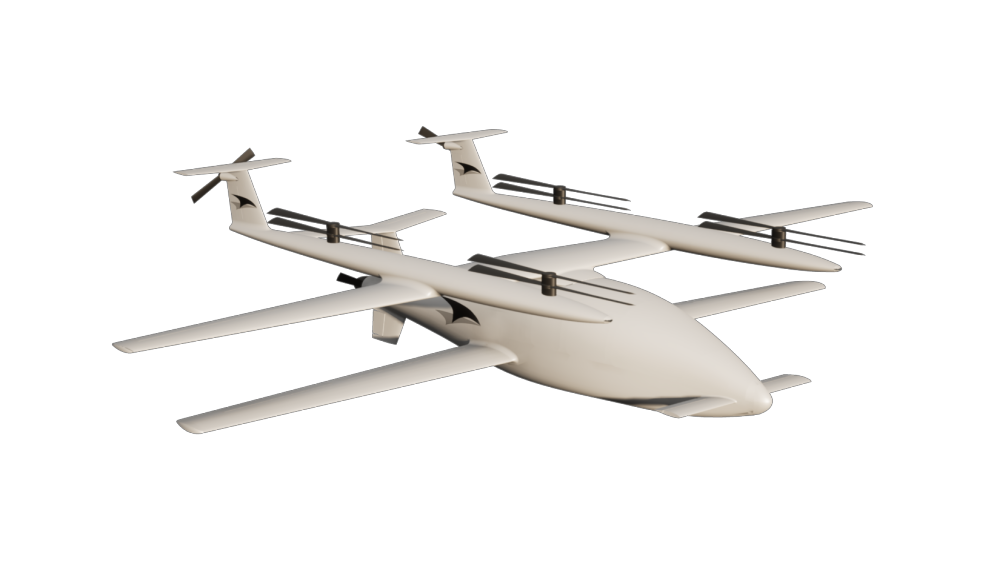On December 11, Los Angeles-based Talyn Air, creators of a 100% electric vertical takeoff and landing aircraft system, inspired by the 2-stage rocket concept, successfully demonstrated in-flight deployment, a major milestone towards proving its concept for runway-free operations for the U.S. Air Force.
Part of a 2-year, $1 million U.S. Air Force Direct to Phase II Small Business Innovation Research (SBIR) contract through AFWERX to revolutionize battlefield logistics, Talyn’s lift vehicle was proven to negate the need for runways or catapults and enables fielding aircraft from virtually anywhere.
AFWERX’s mission is to solve problems and enhance effectiveness by enabling thoughtful, deliberate, ground-up innovation across the Air Force. Its Direct to Phase II contracts allow companies like Talyn to complete feasibility studies and prototype-validated concepts under an accelerated schedule. These contracts are awarded to explore novel, dual-use technologies not otherwise covered by specific SBIR topics and to explore defense related options for solutions useful to the Air Force.
Talyn co-founders, Jamie Gull and Evan Mucasey who, combined, have over a decade of experience developing the Falcon 9 rocket and Dragon spacecraft at SpaceX, have built and tested the company’s 1:4 subscale prototypes. The testing provided initial validation for this first-in-class dual vehicle design. They are now building full scale prototypes for the Air Force.
Gull and Mucasey bring their experience with multi-stage rockets to the eVTOL market with a design that covers more distance at higher speeds than can be accomplished with any single vehicle. The lift-vehicle deploys fully-charged, cruise-optimized aircraft from vertiports. At its final destination, the cruise optimized vehicle docks with a second lift-vehicle. The two land vertically, negating the need for runways and bringing goods closer to their final destination.
The company doubled down on flexibility for its military design. The specialized lift vehicle can be coupled with Air Force fixed wing runway-dependent airframes, including Group 4 and 5 large intelligence, surveillance and reconnaissance (ISR) drones, to launch and recover vertically. This drastically reduces downrange personnel and infrastructure requirements for ISR and other missions.
The cruise vehicle has fixed wings optimized for forward travel and will also be capable of conventional takeoff and landing (CTOL) to provide additional operational flexibility and safety.
These advanced capabilities will be supported by innovations in the airframes, mechanical docking interfaces, autonomy software, and multi-vehicle onboard navigation sensors. Those systems include an autopilot with inertial navigation units, inter-vehicle communication hardware, as well as sensors and software designed specifically to estimate vehicle positions relative to each other.
Company co-founder, Mucasey, was instrumental in the Falcon 9’s first hypersonic orbital reentry and responsible for the design, testing and certification for human spaceflight of the Dragon SpaceCraft pressure vessel, explained the ways Talyns’ eVTOL can improve future mission efficiency and effectiveness:
“We’re designing a flexible architecture which is fundamentally a VTOL-enabler. It supports operations for conventional fixed-wing aircraft by lifting them to altitude, releasing them for their mission, then recovering them with the lift vehicle. This negates the need for long paved runways and centralized infrastructure in theater. Further, Talyn’s cruise vehicle supports fully electric ISR and tactical missions while accommodating a variety of onboard systems to serve broad mission sets. Being fully electric, it has an inherently low acoustic and thermal signature.
And finally, Talyn systems could accomplish intratheater airlift missions without paved runways and at a fraction of the cost of helicopters.”
“These prototype demonstrations prove out the feasibility of Talyn’s technology and set us up for success as we scale up. The Air Force has witnessed our significant progress and signed up to continue supporting us under multiple new contracts.”
Separately, Talyn qualifies for AFWERX’s AFVentures Tactical Funding Increase (TACFI) funding, which would secure it a 2-year effort to design, build, and fly full scale prototypes with Agility Prime as a potential continuation of its existing Phase II. TACFI is a Supplemental Funding Pilot Program (SFPP) program focused on transitioning smaller-scale, tactical capabilities at the operational level.
AFVentures, in collaboration with the Department of the Air Force (DAF) SBIR/STTR Program, recently launched this transition-focused funding opportunity to scale technology development over the “valley of death” by capitalizing current SBIR/STTR Phase II efforts to turn prototypes into Air and Space Force Programs.
Through TACFI, small businesses can receive from $375,000 to $1.7 million in SBIR/STTR funds over a two-year period. For every dollar of SBIR/STTR funds, companies must also receive at least $1 of other government funding (i.e., non-SBIR/STTR) or $1 of private funding. Talyn raised the required private funds in an oversubscribed round earlier this year.
Talyn’s commercial lift-plus-cruise configuration will travel over 300 miles at 200 miles per hour on a single charge while carrying over 1000 pounds of cargo (the equivalent of 5-passengers). This equates to triple the range of other eVTOLs for similar point-to-point flights.


